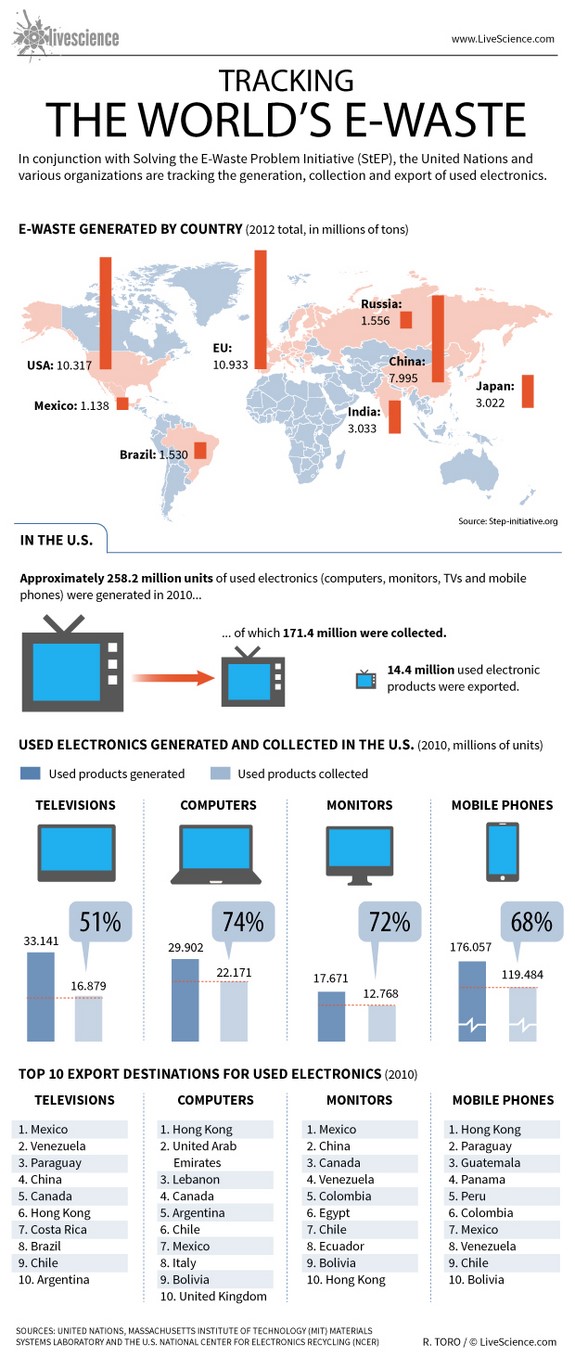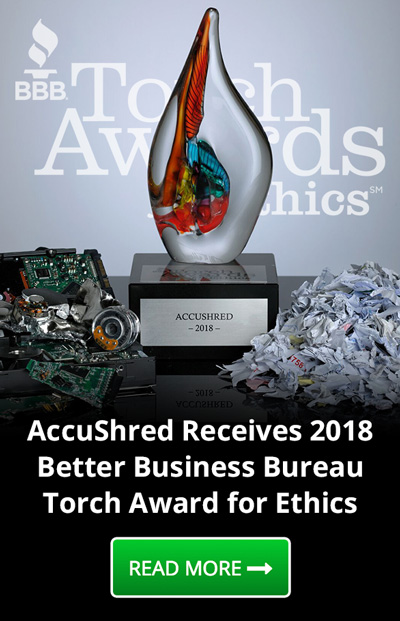Turning E-Waste into an E-Resource
Article by Andrew Burger
http://www.triplepundit.com/2014/06/step-initiative-turning-e-waste-e-resource/
Transforming modern life, the advent of “digital” homes, businesses, governments and societies is yielding tremendous triple bottom line benefits in countries the world over. It has also brought a host of new social and ecological problems and challenges – from the “digital divide” and threats to the security and integrity of vital information to fast growing “mountains” of electronic waste (e-waste).
For the first time, more than 1 billion smartphones were shipped worldwide last year. Phenomenally popular, worldwide tablet shipments rose 68 percent year over year to reach 195.6 million units. Unsurprisingly, e-waste is one of the fastest growing components of our waste stream, forecast to grow by one-third from 2012 levels, to 65.4 million tons, by 2017.
Looking to mimic nature and close the loop on e-waste, the United Nations University Institute for the Advanced Study of Sustainability’s (UNU-IAS) “Solving the E-waste Problem” (StEP) Initiative has been working to raise awareness and help governments, businesses, communities and consumers build the institutional frameworks and capacity to reclaim, recycle and capture the tremendous value e-waste contains. Early this past April, StEP hosted its latest E-Waste Academy for Managers (EWAM) seminar in El Salvador, a country in a region where e-waste, both domestic and imported, poses growing triple bottom line threats.
E-Waste grows along with rise of middle class consumers
A lot has been written, and justifiably so, about the growing number of people in developing world countries that can now be considered “middle class.” Much of this, in turn, has focused on the rise of a middle class of consumers in the world’s two most populous nations – China and India. Growing numbers of middle class consumers and fast growing e-waste volumes pose increasing threats and costs all around the world, however, including across the Latin America-Caribbean (LAC) region.
According to the World Bank, the percentage of LAC region residents considered middle class rose 50 percent over the past decade. Representing 32 percent of regional population, today, for the first time, there are more middle class LAC residents than poor. The rising tide of middle class consumers in the LAC and other developing world regions raises issues of sustainability – social and environmental, as well as economic – to the fore.
QUOTE: “Chock full of potentially toxic metals and plastics, discarded consumer electric and electronic (CE) devices, appliances and equipment pose a large and fast growing threat to ecological, as well as human, health and safety. They also present an opportunity to salvage and capture billions of dollars’ worth of valuable metals, plastics, glass and other materials.”
In a December 2013 study, researchers at U.N. University Institute of Advanced Studies for Sustainability’s (UNU-IAS) StEP Initiative and the Massachusetts Institute of Technology (MIT) forecast that the global volume of discarded refrigerators, TVs, cellphones, computers, monitors and other e-waste will swell three-fold over the ensuing five years – by weight the equivalent of as many as 200 Empire State Buildings.
Engaging stakeholders in the Latin America-Caribbean region

Indicative of the lack of capacity to deal with the growing e-waste problem, governments and societies around the world – developed, developing and less developed – are struggling to cope. Despite concerted efforts, most e-waste continues to be simply discarded and dumped – either locally or by “exporting” it to more welcoming locations, developing and less developed countries in particular, where laborers extract valuable materials in unsafe, harmful conditions.
As UNU-StEP highlights in its news release:
QUOTE: “Though it receives far less foreign e-waste than Africa and Asia, Latin America and the Caribbean is a significant and growing destination for the industrialized world’s discarded refrigerators, small home appliances, televisions, mobile phones, computers, monitors, electronic toys and other electronic products.”
Per-capita e-waste generation across the 30 countries that make up the LAC region averaged 7.5 kilograms (~16.5 lbs.) and is expected to increase 19 percent, to 8.9 kgs (~19.6 lbs.) by 2017, according to UNU-StEP.
Indicative of an inability to cope with growing e-waste streams sustainably, only one-third of the LAC region’s 30 countries have put an e-waste regulatory framework in place. E-waste regulations have advanced furthest in Brazil, Argentina, Colombia, Peru, Bolivia, Chile, Mexico and Costa Rica, and other countries across the LAC region “are proposing or actively working on specific legislation,” UNU-StEP highlights.
There’s a lot of value, and health and environmental threats, being left behind in e-waste. Experts estimate that a mere 10 to 15 percent of the gold in e-waste is being recovered. And it turns out that most of what is being recovered and recycled is taking place in poorer, less developed countries in what’s grown to be an ‘informal’ global network of e-waste importing nations.
As UNU-IAS Director Kazuhiko Takemoto elaborated:“[T]here is great opportunity in the e-waste recycling industry — a sector valued at US$ 9.8 billion in 2012 expected to reach over US$ 40 billion before the end of the decade. ‘Waste management’ is being reinvented as ‘resource management’ because the resources are just too valuable to squander.”
Urban gold mining
Encouragingly, governments, business people and communities are discovering the literal ‘gold mine’ residing in e-waste streams. More and more gold, silver and other precious metals are being recovered as global CE device sales, trade and waste continue to grow at rapid rates.
The world’s gold supply increased 15 percent, from some 3,900 tons in 2001 to 4,500 tons in 2011, while the price rose from less than $300 to more than $1,500 an ounce, e-waste experts have noted. The amount of gold contained in e-waste totaled 97 tons, 5.3 percent of the world’s annual gold supply, in 2001. That rose to 7.7 percent in 2011, UNU-StEP e-waste experts noted.
Gold and silver aren’t the only valuable metals being discarded in e-waste streams and trash dumps. Significant amounts of increasingly rare, valuable and costly-to-mine metals such as copper, tin, cobalt and palladium are present as well, as are plastics.
Experts estimate that recycling just half the plastics in e-waste from the European Union alone would save 5 million kilowatt-hours (kWh) of energy, more than 3 million barrels of oil feedstock, and eliminate nearly 2 million metric tons of CO2 emissions.
QUOTE: “One day — likely sooner than later — people will look back on such costly inefficiencies and wonder how we could be so short sighted and wasteful of natural resources,” said Ruediger Kuehr, UN StEP’s executive secretary. “We need to recover rare elements to continue manufacturing IT products, batteries for electric cars, solar panels, flat-screen televisions and other increasingly popular products.”
UNU-StEP’s Regional e-waste management seminars
Its regional EWAM seminars are a core facet of UN StEP’s strategic plan to tackle a growing e-waste problem and turn it into a triple bottom line opportunity. By sharing insights on “urban mining” and fostering international linkages and collaboration on sustainable e-waste management, the EWAM seminars, along with complementary events for scientists, are yielding local solutions to a fast growing global problem.
Eighteen participants from 10 LAC countries and three from Africa attended UN StEP’s April EWAM seminar in El Salvador. Sponsored by EMPA/SECO, the NVMP Foundation, the U.S. EPA, Nokia, GeSI, HP, Dell and the U.N. International Development Organization (UNIDO) and World Loop, they engaged 14 e-waste experts from leading institutions, such as the U.S. EPA, MIT, Switzerland’s World Resources Forum, and multinational precious metal recycler Umicore. Also participating were seven “facilitators” from IT manufacturers including Dell, HP and Nokia, as well as UNIDO








